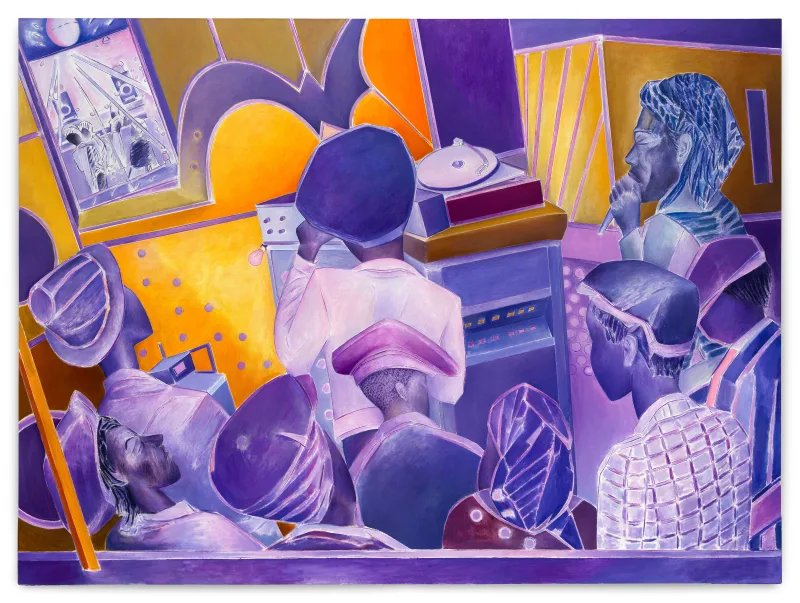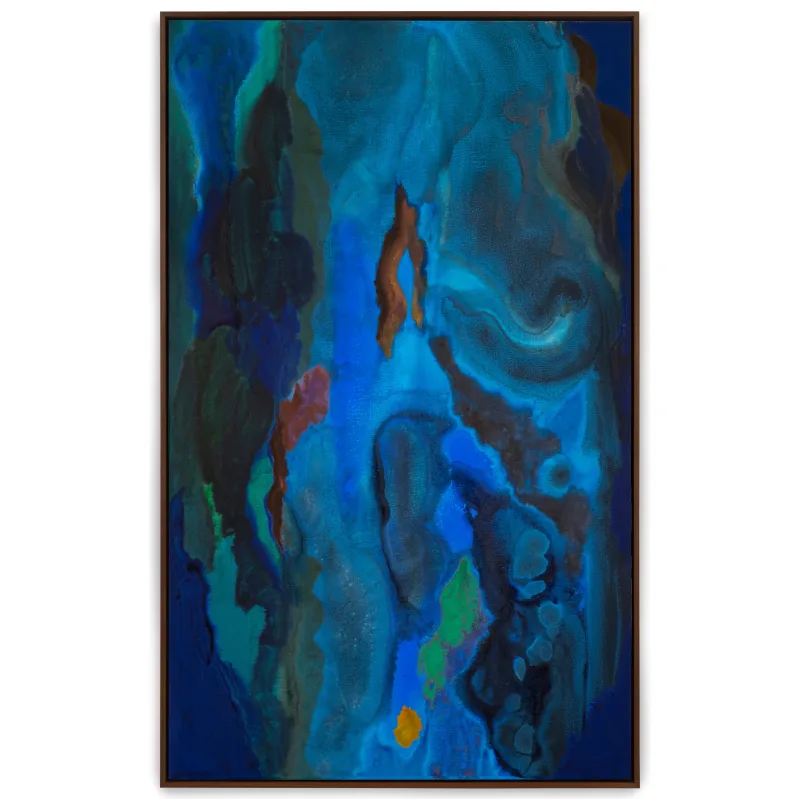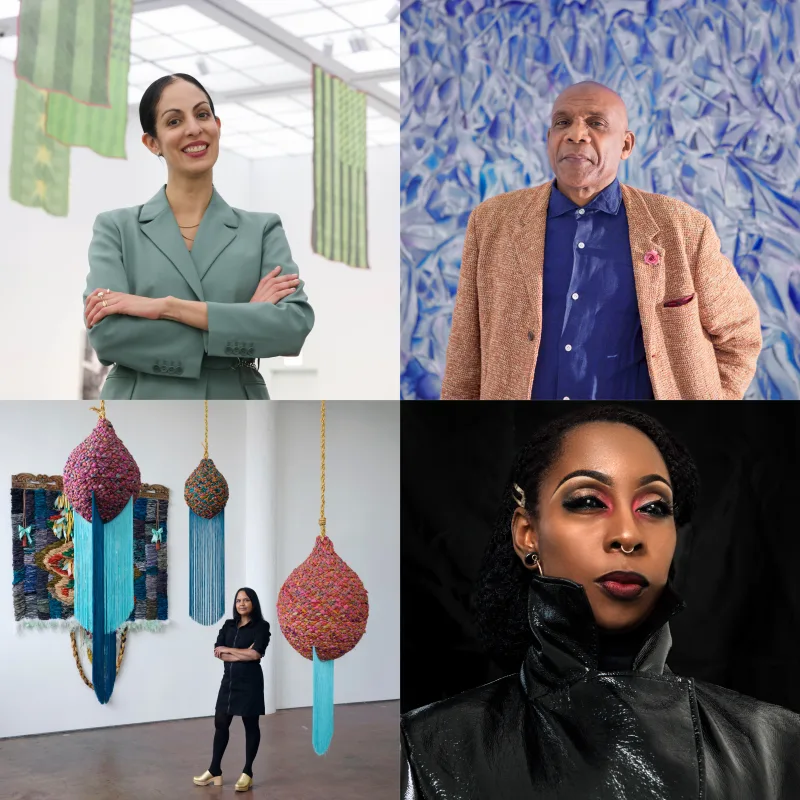
Group Exhibition: Reverb
Overview
Stephen Friedman Gallery presents 'Reverb', an exhibition bringing together new works by eight leading artists from the Caribbean diaspora: Julien Creuzet, Denzil Forrester, Hulda Guzmán, Suchitra Mattai, Zinzi Minott, Kathia St. Hilaire, Charmaine Watkiss and Alberta Whittle.
Comprising paintings, sculptures, mixed media and sound-based works, Reverb foregrounds the significance of contemporary art from the Caribbean region.
Drawing on the legacy of Life Between Islands at Tate Britain (2021) and Forecast Form at MCA Chicago (2022), the exhibition takes inspiration from Michael Veal’s (Professor of Ethnomusicology at Yale University) description of dub music and its use of reverb as a “sonic metaphor for the condition of diaspora”. Reverb is an effect that occurs when sonic waves bounce off surfaces and create a series of echoes that gradually fade away, making the listener feel like they are physically enveloped by sound. Julian Henriques (Professor at Goldsmiths, University of London) compares the visceral vibrations of Caribbean music to the far-reaching impact of its people and cultures, writing that “the dancehall session serves as a model for diasporic propagation”. Like ripples across the ocean, these reverberations communicate stories of identity, nature and colonialism.
Stephen Friedman Gallery presents Reverb, an exhibition bringing together new works by eight leading artists from the Caribbean diaspora: Julien Creuzet, Denzil Forrester, Hulda Guzmán, Suchitra Mattai, Zinzi Minott, Kathia St. Hilaire, Charmaine Watkiss and Alberta Whittle. Comprising paintings, sculptures, mixed media and sound-based works, Reverb foregrounds the significance of contemporary art from the Caribbean region.
Drawing on the legacy of Life Between Islands at Tate Britain (2021) and Forecast Form at MCA Chicago (2022), the exhibition takes inspiration from Michael Veal’s (Professor of Ethnomusicology at Yale University) description of dub music and its use of reverb as a “sonic metaphor for the condition of diaspora”. Reverb is an effect that occurs when sonic waves bounce off surfaces and create a series of echoes that gradually fade away, making the listener feel like they are physically enveloped by sound. Julian Henriques (Professor at Goldsmiths, University of London) compares the visceral vibrations of Caribbean music to the far-reaching impact of its people and cultures, writing that “the dancehall session serves as a model for diasporic propagation”. Like ripples across the ocean, these reverberations communicate stories of identity, nature and colonialism.
Suchitra Mattai’s multi-disciplinary practice draws on her South Asian heritage and her ancestors’ migration from India to British Guiana on South America’s north Atlantic coast — now Guyana — as indentured labourers in the 19th century. The artist’s work incorporates materials and domestic craft techniques typically associated with female labour that have been passed down through generations. Mattai’s imposing new tapestry set free combines woven vintage saris with beaded fringing and shimmering gold tassels. A female figure floats in the centre of the composition as if drifting through time and space, alluding to the sense of displacement Mattai relates to the experience of Indo-Caribbean immigrants.
Using dance, film and sound, Zinzi Minott’s work is similarly concerned with telling migratory histories. Building on her seminal piece BLOODSOUND (2022), currently on view at Walker Art Gallery in Liverpool, Minott has created a new sound work inspired by the waters travelled by her Jamaican ancestors. The work draws on archival material, political speeches, field recordings of carnivals, bodies of water, glitches and found sound to weave together a sonic tapestry of diasporic journeys.
Denzil Forrester, born in Grenada and now based in Cornwall, England also looks at the significance of sound in Caribbean culture. Forrester is known for his vibrant paintings that immortalise the dynamic energy of the London reggae and dub nightclub scene during the early 1980s, a subject that has endured throughout four decades of his practice. Zulu Chant (2023–24) was the first painting Forrester made after the death of legendary DJ Jah Shaka. Rendered in rich shades of indigo, yellow and lilac, this large-scale work depicts a crowd of revellers encircling Shaka and his totemic sound system. This is accompanied by a vibrant new drawing which captures the nascent dub scene that has grown in Cornwall in recent years.
Fellow British-based artist Charmaine Watkiss was born in London to Jamaican parents. Watkiss creates detailed works on paper which explore the relationship between ancestry and botany. This ongoing body of work explores the indigenous knowledge that West African women brought to the Caribbean, focusing on the traditional healing properties of plants passed down from their ancestors. Her new drawings in Reverb are underpinned by research undertaken at The British Museum, looking into Sir Hans Sloane’s (1660–1753) documentation of plants during his time as a physician to slave plantations in Jamaica. Watkiss’ figures, confident in their stature and based on the artist’s likeness, manifest the wisdom and resilience she associates with Caribbean women.
Alberta Whittle’s practice likewise presents a personal response to the legacies of the transatlantic slave trade. Two new textile works stretched on vibrantly painted frames – Beneath the waves, we shapeshift (before I was a shipworm) and Beneath the waves, we shapeshift (before I was a hermit) – are featured in the exhibition. Resting on wheels, these sculptures gesture toward performance or movement. Door-like in structure, Whittle envisages them as portals or passageways to an alternative future by depicting various forms of resistance. Both reference the myth of Drexciya – an Afrofuturist story about an underwater empire created by the unborn children of enslaved African women – by depicting an interspecies relationship between a woman and a hermit crab.
Julien Creuzet similarly reflects on ecology in relation to colonialism. Creuzet grew up in Martinique and is currently representing France at the 60th edition of La Biennale di Venezia. For Reverb, the artist has made a new series of sculptures – twisted, colourful configurations hanging from the ceiling which repurpose detritus washed up on the seashore. These works allude to the Caribbean’s troubled history of colonial trade by highlighting its harmful ecological consequences. By transforming these disregarded objects into joyful assemblages, Creuzet’s sculptures manifest a sense of hope for the future.
Sharing an interest in the natural world, Hulda Guzmán’s vibrant and psychedelic paintings focus on the artist’s utopic surroundings in the Dominican Republic. In a new self-portrait, Guzmán depicts herself having an out of body experience. Reclining on a chequered table, she is surrounded by her pet cats, a towering, alien-like flower and two family members – her father is seen reclining on the left, while her godfather, no longer alive, is depicted as a celestial being on the right. This spiritual ‘get-together’ manifests Guzmán’s belief that we are all interconnected as part of a vast ecosystem, further emphasised by the lush backdrop of her coastal studio and the vast horizon.
Also drawing on fantasy and spiritualism, Kathia St. Hilaire's practice fuses together printmaking, painting, collage and weaving. Informed by her upbringing as the daughter of two Haitian immigrants in Florida, her work addresses the history and culture of the island nation. Inspired by the writings of Rita Dove and René Philoctète, the figures depicted in St. Hilaire’s multi-layered new works reference the Parsley Massacre of 1937, when Dominican soldiers were ordered by military dictator Rafael Trujillo to kill Haitians living near the Dominican-Haitian border. The paintings feature motifs including banana leaves, avocados and flowers – all inspired by her parents’ garden. St. Hilaire uses them as ‘offerings’ to reference the Haitian Vodou spirit Azaka, the spirit of agriculture and peasant farmers, and honour the Haitians and Dominicans living in the border town murdered by Trujillo.
Reverb coincides with a major exhibition by Denzil Forrester at Stephen Friedman Gallery and Andrew Kreps Gallery in New York.
The exhibition is accompanied by a new text written by Rianna Jade Parker (writer, critic and curator, and author of A Brief History of Black British Art (Tate, 2021)).
Stephen Friedman Gallery presents 'Reverb', an exhibition bringing together new works by eight leading artists from the Caribbean diaspora: Julien Creuzet, Denzil Forrester, Hulda Guzmán, Suchitra Mattai, Zinzi Minott, Kathia St. Hilaire, Charmaine Watkiss and Alberta Whittle.
Installation Views











Selected Artworks



























